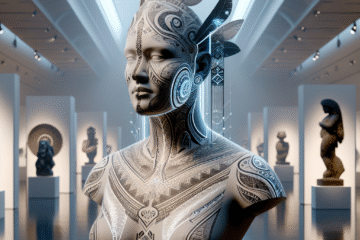Introduction: Painting the Self into Being
The iconic phrase “I think therefore I am” by René Descartes forms the skeleton of Western notions of identity and consciousness. But for Abstract Expressionists such as Joan Mitchell and Franz Kline, thought was not enough—only through the act of painting could one truly be. This existential approach finds a resonant echo in phenomenology, the philosophical movement that emphasizes lived experience, perception, and bodily being-in-the-world. In this article, we traverse the gestural fields of Abstract Expressionism, interpreting their visual language through a phenomenological lens, and tracing how perception, embodiment, and identity manifest in paint.
1. The Rise of Phenomenology and the Shift Toward the Inner World
The early twentieth century was a period of intellectual upheaval. Physics rewrote the laws of reality, Freud introduced the unconscious, and Husserl and Heidegger reshaped philosophy with phenomenology. Phenomenology urged focus on the structures of experience itself and privileged intentionality—the notion that all consciousness is consciousness of something. Maurice Merleau-Ponty, a key figure in this movement, emphasized the body as the primary site of knowing the world. Art, in this context, became not a representation of reality but an extension of our perceptual being.
As European artists grasped with this internal turn, modernist painting began shedding the figural and mimetic. Movements like Cubism fragmented space and time, while Surrealism delved into dreamscapes. As the Axis powers rose and war erupted, many artists—along with ideas—migrated to New York. Seeded in this fertile intellectual soil, Abstract Expressionism took root.
2. The Canvas as the Field of Being: Action Painting
New York in the 1940s and 1950s was electrified by a new artistic language. Influenced by existential philosophy, Jungian psychology, and theories of the subconscious, Abstract Expressionists redefined painting as an event rather than a product. Artists such as Jackson Pollock, Franz Kline, and Willem de Kooning saw the canvas not as a window but as a field—a space of encounter between self and world, mind and gesture.
Franz Kline’s bold black brushstrokes, often resembling hieroglyphs exploded across space, embodied an essential phenomenological insight: that perception is grounded in action. His approach recalls Merleau-Ponty’s idea that “the body is our general medium for having a world.” Kline’s works are motor utterances, irreducible to symbols yet deeply communicative. Looking at them is watching intention made visible, raw and unfiltered by representation.
3. Joan Mitchell and the Emotional Topography
Joan Mitchell appeared in the scene slightly later but deeply extended its expressive vocabulary. While many male Action Painters focused on physical aggression or existential angst, Mitchell’s work navigated subjective emotion, memory, and landscape. For Mitchell, the gestures were not only acts of being but emotional cartographies—what Merleau-Ponty might have described as “the flesh of the visible.”
Her layered, dynamic strokes convey sensations rather than depictions—wind over water, a remembered garden, grief swelling in color. These are not mere expressions of the inner self; they are the process through which the self becomes articulated. In Mitchell’s practice, painting is less about making something external than about revealing the very structures of experience. Her art insists: “I perceive, therefore I am.”
4. Technology, Reproduction, and the Unrepeatable Gesture
The Abstract Expressionists emerged in an era increasingly saturated by mass production and mechanical reproduction—a theme famously explored by Walter Benjamin. The cinema, photography, and color printing had already transformed public access to images. Against this backdrop, the spontaneous, gestural mark became a way to reclaim authenticity. Each brushstroke was unique, time-bound, and irreplicable—a trace of bodily presence resisting the abstracting forces of modern technology.
Kline’s massive monochromes and Mitchell’s immersive color fields highlight the primacy of touch and immediacy in an age of replicas. In their commitment to gesture, these artists foreground the temporal nature of making; every swipe of the brush is a ‘now,’ a living intersection of memory, perception, and becoming. This authenticity through embodiment gave the movement its philosophical gravitas.
5. Legacy and the Phenomenological Gaze Today
Today, contemporary artists continue to grapple with ideas first radicalized by the Abstract Expressionists. In a post-digital age flooded with hyperreality and virtual presence, the primacy of lived experience regains urgency. Paintings that assert bodily presence through direct mark-making serve as counterpoints to disembodied digital images.
Phenomenology, with its emphasis on perception and being, still provides a fertile framework. Artists influenced by Mitchell and Kline often return to gesture, scale, and materiality. Their works demand not passive viewing but active engagement—asking the viewer to not simply look but to feel, move, and be moved. In this sense, every brushstroke stands as a philosophical statement: being is not static, but enacted. “I paint therefore I am.”
Conclusion: The Painted Self
The Abstract Expressionists did not merely paint pictures. They mined the very experience of painting—its rhythms, hesitations, and eruptions—to find identity. Through the body, intention, and gesture, they enacted the phenomenological truth that humans are not detached minds but embodied perceivers. In the gestures of Mitchell and Kline, art becomes more than aesthetic; it becomes ontological—a mode of being. What remains is not a finished image, but a record of presence. In a world still searching for meaning between screens and surrogates, their work whispers an enduring truth: we are, because we move, we feel, and we paint.



